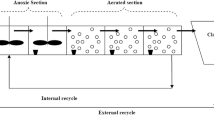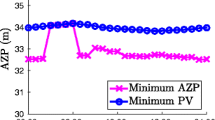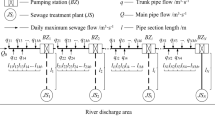Abstract
This paper presents a new approach for the optimal design of distributed wastewater treatment networks with multiple contaminants. It consists of a two-stage solution strategy. In the first stage, a decomposition method is employed that replaces the general non-linear program (NLP) by a succession of linear programs, one for each treatment unit. In the second stage, the resulting network is used as a starting point for the solution of the general NLP by a local optimization solver. The decomposition process considers a specific substructure, where it is assumed that the wastewater streams go through the treatment units in sequence. To consider all combinations, the two-stage solution strategy is applied as many times as the number of possible sequences. This allows considering multiple and structurally different starting points, thus increasing the probability of finding global optimal solutions. The results have shown that the proposed approach can find better solutions than other approach reported in the literature, however with a drawback of being more demanding computationally.











Similar content being viewed by others
Abbreviations
- LP:
-
Linear program
- MINLP:
-
Mixed-integer nonlinear program
- NLP:
-
Nonlinear program
- WUN:
-
Water-using network
- WUTN:
-
Water-using and treatment network
- WTN:
-
Wastewater treatment network
References
Aly S, Abeer S, Awad M (2005) A new systematic approach for water network design. Clean Technol Environ Policy 7:154
Bagajewicz M (2000) A review of recent design procedures for water networks in refineries and process plants. Comput Chem Eng 24:2093
Castro P, Matos H, Fernandes MC, Nunes CP (1999) Improvements for mass-exchange networks design. Chem Eng Sci 54:1649
Castro PM, Matos HA, Novais AQ (2007) An efficient heuristic procedure for the optimal design of wastewater treatment systems. Resour Conserv Recycle 50:158
Doyle S, Smith R (1997) Targeting water reuse with multiple contaminants. Trans IChemE 75(B):181
El-Halwagi MM, Gabriel F, Harell D (2003) Rigorous graphical targeting for resource conservation via material recycle/reuse networks. Ind Eng Chem Res 42:4319
Feng X, Seider W (2001) New structure and design methodology for water networks. Ind Eng Chem Res 40:6140
Galan B, Grossmann IE (1998) Optimal design of distributed wastewater treatment networks. Ind Eng Chem Res 37:4036
Gunaratnam M, Alva-Argáez A, Kokossis A, Kim J, Smith R (2005) Automated design of total water systems. Ind Eng Chem Res 44:588
Hernández-Suárez R, Castellanos-Fernández J, Zamora JM (2004) Superstructure decomposition and parametric optimization approach for the synthesis of distributed wastewater treatment networks. Ind Eng Chem Res 43:2175
Huang C, Chang C, Ling H, Chang C (1999) A mathematical programming model for water usage and treatment network design. Ind Eng Chem Res 38:2666
Karuppiah R, Grossmann IE (2006) Global optimization for the synthesis of integrated water systems in chemical processes. Comput Chem Eng 30:650
Karuppiah R, Grossmann IE (2008) Global optimization of multiscenario mixed integer nonlinear programming models arising in the synthesis of integrated water networks under uncertainty. Comput Chem Eng 32:145
Kuo WJ, Smith R (1997) Effluent treatment system design. Chem Eng Sci 52:4273
Kuo W, Smith R (1998) Designing for the interactions between water-use and effluent treatment. Trans IChemE 76(A):287
Lim S-R, Park JM (2008) Synthesis of an environmentally friendly water network system. Ind Eng Chem Res 47:1988
Liu Y, Duan H, Feng X (2008) The design of water-reusing network with a hybrid structure through mathematical programming. Chin J Chem Eng 16:1
Manan Z, Tan Y, Foo D (2004) Targeting the minimum water flow rate using water cascade analysis technique. AIChE J 50:3169
Ng D, Foo D (2006) Evolution of water network using improved source shift algorithm and water path analysis. Ind Eng Chem Res 45:8095
Prakash R, Shenoy U (2005) Targeting and design of water networks for fixed flowrate and fixed contaminant load operations. Chem Eng Sci 60:255
Relvas S, Matos H, Fernandes M, Castro P, Nunes C (2008) AquoMin: a software tool for mass-exchange networks targeting and design. Comput Chem Eng 32:1085
Takama N, Kuriyama T, Shiroko K, Umeda T (1980) Optimal water allocation in a petroleum refinery. Comput Chem Eng 4:251
Teles JP, Castro PM, Novais AQ (2008) LP-based solution strategies for the optimal design of industrial water networks with multiple contaminants. Chem Eng Sci 63:376
Tsai M, Chang C (2001) Water usage and treatment network design using genetic algorithms. Ind Eng Chem Res 40:4874
Wang B, Feng X, Zhang Z (2003) A design methodology for multiple-contaminant water networks with single internal water main. Comput Chem Eng 27:903
Wang Y, Smith R (1994a) Wastewater minimization. Chem Eng Sci 49:981
Wang Y, Smith R (1994b) Design of distributed effluent treatment systems. Chem Eng Sci 49:3127
Acknowledgments
The authors gratefully acknowledge the financial support from Fundação para a Ciência e Tecnologia through project PTDC/AMB/64659/2006 and research grant SFRH/BD/41062/2007.
Author information
Authors and Affiliations
Corresponding author
Additional information
An erratum to this article can be found at http://dx.doi.org/10.1007/s10098-008-0184-1
Rights and permissions
About this article
Cite this article
Castro, P.M., Teles, J.P. & Novais, A.Q. Linear program-based algorithm for the optimal design of wastewater treatment systems. Clean Techn Environ Policy 11, 83–93 (2009). https://doi.org/10.1007/s10098-008-0172-5
Received:
Accepted:
Published:
Issue Date:
DOI: https://doi.org/10.1007/s10098-008-0172-5




